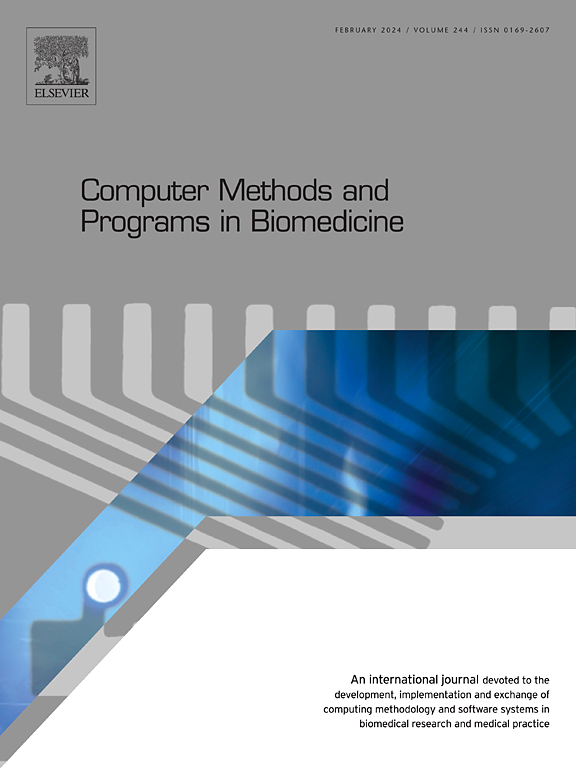基于浅表数据的疾病多标签预诊断的机器学习策略
IF 4.9
2区 医学
Q1 COMPUTER SCIENCE, INTERDISCIPLINARY APPLICATIONS
引用次数: 0
摘要
背景与目的全科医生(GP)预诊断是疾病分诊中的一项关键任务,尽管数据有限且存在多标签分类挑战,但仍可将患者引导到合适的科室。为了解决这个问题,提供了一个带有降维机器学习策略的框架。方法对疾病信息进行分层组织,主要关注疾病总体分类(i级)及其子分类(ii级)。介绍了两种机器学习策略并将其嵌入到一个框架中。一种是分类器链策略,另一种是集成学习-深度神经网络(dnn)策略。在分类器链中,基本候选算法包括XGBoost、RF(随机森林)、LR(逻辑回归)和SVM(支持向量机)。在GP预诊断中,逐步推断出i级和ii级疾病信息。通过3124例主诉腹痛患者的回顾性电子病历证明了该方法的有效性。性能指标包括AUPRC、AUROC、F1、准确性、敏感性、特异性和汉明损失。使用Friedman测试比较不同机器学习方法的性能,然后使用Nemenyi事后测试。结果统计结果表明,分类器链-射频方法是最优的。对于总体疾病分类,性能非常好,几乎所有指标都超过0.90。对于疾病子类,表现略有下降,但仍然非常有效,大多数指标超过0.80。结论所提出的框架在各种指标上表现良好,并成功实现了既定目标,显示了其有效性,为全科医生预诊断的特定领域的计算机辅助诊断提供了见解。分类器链-射频被推荐作为一种嵌入方法。本文章由计算机程序翻译,如有差异,请以英文原文为准。
Machine learning strategies for multi-label pre-diagnosis of diseases with superficial data
Background and objective
General practice (GP) pre-diagnosis, a key task in disease triage, directs patients to suitable departments despite limited data and multi-label classification challenges. To address this issue, a framework with dimensionality reduction machine learning strategies was provided.
Methods
Disease information was organized into hierarchical tiers, focusing primarily on overarching disease classifications (I-level) and their subcategories (II-level). Two machine learning strategies were introduced and embedded into a framework. One was the classifier chain strategy, and the other one was ensemble learning-DNN (Deep Neural Networks) strategy. In classifier chains, the base candidate algorithms included XGBoost, RF (Random Forest), LR (Logistic Regression), and SVM (Support Vector Machine). In GP pre-diagnosis, the I-level and II-level disease information was progressively inferred. The efficacy of the methodologies was demonstrated through 3124 retrospective electronic medical records of patients complaining of abdominal pain. The performance metrics included AUPRC, AUROC, F1, accuracy, sensitivity, specificity, and hamming loss. The performance of different machine learning approaches was compared using the Friedman test, followed by the Nemenyi post-hoc test.
Results
The statistical results indicated that the Classifier chain-RF approach was optimal. For overarching disease categorizations, performance was excellent with nearly all metrics exceeding 0.90. For disease subcategories, performance slightly declined but remained highly effective, with most metrics surpassing 0.80.
Conclusions
The proposed framework exhibited its efficacy by performing well across various metrics and successfully accomplishing the established objectives, contributing insights to computer-aided diagnosis in the specific area of GP pre-diagnosis. Classifier chain-RF is recommended as an embedding approach.
求助全文
通过发布文献求助,成功后即可免费获取论文全文。
去求助
来源期刊

Computer methods and programs in biomedicine
工程技术-工程:生物医学
CiteScore
12.30
自引率
6.60%
发文量
601
审稿时长
135 days
期刊介绍:
To encourage the development of formal computing methods, and their application in biomedical research and medical practice, by illustration of fundamental principles in biomedical informatics research; to stimulate basic research into application software design; to report the state of research of biomedical information processing projects; to report new computer methodologies applied in biomedical areas; the eventual distribution of demonstrable software to avoid duplication of effort; to provide a forum for discussion and improvement of existing software; to optimize contact between national organizations and regional user groups by promoting an international exchange of information on formal methods, standards and software in biomedicine.
Computer Methods and Programs in Biomedicine covers computing methodology and software systems derived from computing science for implementation in all aspects of biomedical research and medical practice. It is designed to serve: biochemists; biologists; geneticists; immunologists; neuroscientists; pharmacologists; toxicologists; clinicians; epidemiologists; psychiatrists; psychologists; cardiologists; chemists; (radio)physicists; computer scientists; programmers and systems analysts; biomedical, clinical, electrical and other engineers; teachers of medical informatics and users of educational software.
 求助内容:
求助内容: 应助结果提醒方式:
应助结果提醒方式:


